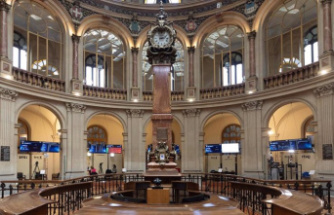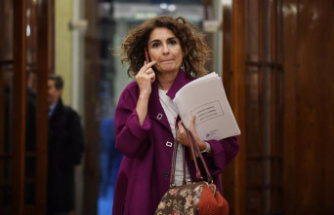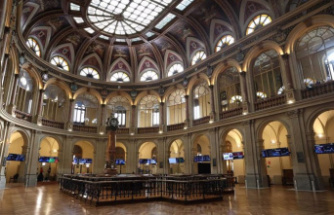He affirms that there is "an upward cycle" influenced by the decision of the American company Freeport to delay its start-up
SEVILLA, 5 Dic. (EUROPA PRESS) -
The price of electricity could return to 300 euros per megawatt hour (Mwh) reached last August, in a geopolitical context in which the arrival of winter is expected to hit both EU countries and Russia hard. , with which the values of the Iberian Gas Market (Mibgas) could exceed 240 euros, according to estimates by Tempos Energía.
The general director of Tempos Energía, Antonio Aceituno, has indicated that if there were a drastic drop in temperatures in the regions that most import gas, such as Germany, whose reserves could only last a few weeks, the Mibgas values "would skyrocket".
The imminent arrival of winter has raised a "worrying" scenario that would cause the price of electricity to fluctuate between 300 and 400 euros per megawatt hour. For the expert, the most optimistic variable would be that if "kind" weather continues, gas inventories in Europe will be depleted by about two-thirds this winter, as long as Russian flows continue through Ukraine.
"This scenario would allow values, for the price of electricity, 'pool' plus adjustment mechanism, close to 300 euros," said the expert. However, in the event that winter hits the north and center of the Old Continent hard and Russia chooses to cut gas flows by 10% of the total, "Europe would face a totally adverse scenario."
"This is mainly due to the fact that Germany, affected by a notable drop in temperatures, would only have reserves for eight or ten weeks," he pointed out, after stating that this situation, in the worst case, would place the price of electric megawatt hour above 400 euros, the energy management expert has warned.
Regarding fluctuations in the gas market price, Aceituno has argued that "it is possible that we are at the beginning of an upward cycle"; a trend that, according to him, "finds one of its main reasons in the recent announcement by the second largest liquefied natural gas export terminal in the US, Freeport, to delay its start-up until mid-December."
Freeport represents 17% of the liquefaction capacity of the US, an amount that was exported in its entirety to Europe before the fire, in June 2022, so the consequences of this measure will be direct for the Old Continent, he stressed.
Likewise, the general director of Tempos Energía has highlighted that another of the factors that invite us to think about the upward trend in gas prices has been Gazprom's threat to stop its shipments through Ukraine, its last route. "It is a sign that the supply of this resource could be reduced," he said.
"In addition, we have to add that the volume of Liquefied Natural Gas (LNG) expected to be unloaded off the European coast, for at least five days, has halved from the maximum of two billion cubic meters seen on October 23, to just over 1,000 million cubic meters or only twelve vessels," the expert added.
This is a question that "is directly related to a colder climate outlook, which has significantly boosted bullish sentiment," Aceituno stressed.
"The next three months are going to depend in a significant way on two big unknowns: the amount of Russian supply that leaves the market after the entry into force of the sanctions on December 5, and when and how quickly demand will recover in China". Looking at this last part of the equation, "markets expect a significant easing of coronavirus restrictions, only starting in March or April at the earliest," Aceituno said.
In addition, the reopening of the country next year could be "round trip", since "officials may back down if Covid cases skyrocket since, although two thirds of Chinese 80 years or older are fully vaccinated, only 40 percent are boosted."
However, the general director of Tempos Energía has maintained that "the first part of the equation is the really complicated one, opening up two possibilities in terms of prices". The most favorable path for Europe is for Moscow "to manage to redirect all its displaced oil, hoping that it reaches a maximum of 1.5 thousand barrels per day." A fact that would allow Brent "to move between 80 and 90 dollars per barrel, taking into account the weakness of China and the size of inflation that the markets are dealing with right now," he added.
Aceituno has warned that "if the market-oriented partners, a term applied by the Russian Deputy Prime Minister, Alexander Novak, are not capable of handling the new puzzle", the cost of crude oil "has a high chance of being between 110 and $120 a barrel."
As for the current crude oil market, "it can be seen how demand is softening," according to Aceituno. However, the expert has pointed out that "there is an excess supply in the short term, since in recent days futures contracts have entered and exited the contagion, which indicates that the immediate price is lower than the future cost" .
Thus, the general director of Tempos Energía has indicated that the upcoming actions by Russia and China will be "determinant for the development of the oil market". When it comes to the Russian oil cap situation, EU countries "are forced to choose between two priorities that are almost impossible to resolve: trying to stifle revenues from Russia, and avoiding potentially painful spikes in oil." oil price that could hurt the global economy.
Regarding this double problem, "European countries have been discussing establishing a ceiling for the price of a barrel of oil (bbl) that oscillates between 65 and 70 dollars per barrel," according to Aceituno. A measure that, according to the expert, "would hardly affect the position of Russia, whose production costs are minimal, around 20 dollars per barrel, compared to this ceiling."
Also, Russian crude is currently trading at a significant discount to Brent, at around $65 per barrel of oil, in line with what Asian buyers are already paying.













